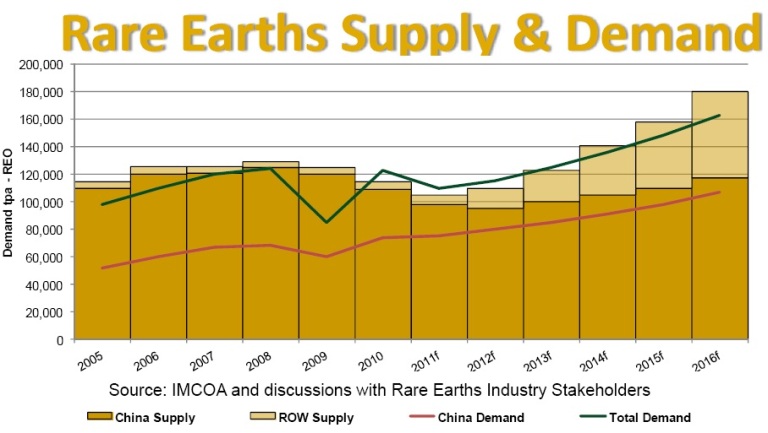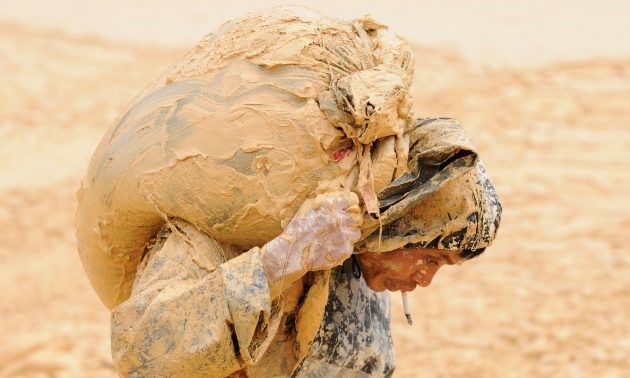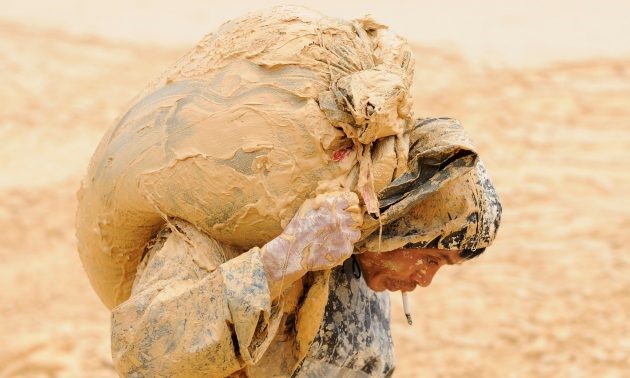Rare earth element (REE) mainly consists of seventeen chemical elements. REE are crucial in nowadays technology as they can optimise the performance of high-tech products such as smartphones, wind turbines and missile defence systems. However, REEs have to be extracted from ores, then purified and processed before any applications. Some reported that companies often underestimate the negative impacts of REE bringing to the environment and miners at the sites. An ethical topic issue about REE – “Should REE be developed and monitored locally?” is identified,
Increase of competitiveness among countries and technology development in rare earth production
China controls about 95% of the world’s rare earth production. But meanwhile, it is also the dominant consumer of REE in order to manufacture electronic products for domestic and export markets. For example, laptops, digital cameras, hybrid vehicles and cell phones. They all operate with rechargeable batteries which are made with rare earth compounds. In 2010, there was the export quota reduction by China that caused the prices for rare earth materials increase dramatically in those few years.
However, due to these high prices, the competitiveness in REE industry is rising. Mining companies in other countries have begun to reevaluate old rare earth prospects and find new sources of supply. Besides, mines in both Australia and United States have re-started the production of rare earth oxides again since 2011. They supplied about 6-8% of world production between 2012 and 2015. Nowadays, more manufacturers in other countries also started taking roles in production, such as Vietnam, Brazil, Russia and Malaysia. These actions made the production percentage of China decreased to 86% in 2012.
In 2016, although China was still the world leader in rare earth production, they only control around 36% of the world’s rare earths reserves. This gives an opportunity for the manufacturers from other countries to take important roles in production.
To determine the market price of an item, people always focus on its supply and demand. As supply decreases, prices will obviously go up. At that time, mining companies would see this as an opportunity and attempt to develop alternative resources, such as expanded recycling, coal and coal ash and deep sea deposits. This prevents from negative effects caused by a dominant world producer. When manufacturers explore further potential reserves around the world, this would strike a balance between supply and demand, although the demand would keep on increasing during the next decades because of various applications of REE. And the prices would become more stable.

To compete with other opponents in the industry of REE, price and quality play as key roles. Price factor is affected by supplying quantities. In other words, it means the production rate. Some countries may want to produce more REEs but they do not have a lot of REE reserves. Another method for them to increase its competitiveness is finding new or special technique and high technology to refine REE with higher purity. Marketing studies reveal that the price of high purity REEs have sharply increased past few decades as the demand of highly purified REEs increase gradually in order to improve the efficiency of downstream products.
Such developments do not only provide higher purity in REEs, but also new and effective refinery process may be developed. For instance, using ionic extractor to extract REE in coal is more environmental-friendly and energy efficient comparing to traditional mining process.
Environmental, storage issue with cities nearby society and working areas
As there is a rapid demand on REE, the quantity of production is apparently rank in priority to the quality of miners’ health and safety. In addition, coltan, a rare mineral which is a very commonly-seen conductor in nowadays smartphone but it is not as commonly seen for the miners in the Democratic Republic of the Congo (DRC), who search for its existence 12 hours a day. The negative health impacts to workers from long-term exposure to REEs may be inevitable, however the terrible working conditions exposed that insufficient health and safety measures are provided from the companies.

Reported by Daily mail, miners with youngest age of 10 were only provided with rudimentary equipment to excavate coltan in DRC while some even used bare hands to filter out precious minerals by sluice similar to those used in a 19th century gold rush. Beside the unreasonably long working hours, there was no shelter on the exposed mountain for rest under the midday sun. Furthermore, it was reported that seven workers were killed because of a poorly-supported tunnel collapse. Meanwhile, poor hygiene and the unsafe act of not wearing breathing respirators among workers also happened in China, which contributes to radiation risk when processing REEs. The companies should acknowledge the health risks and the responsibility to ensure safety measures are adopted, civilised working conditions are provided and strict restrictions on working hours and age are implanted especially when REEs are developed locally.
Beside the harmful effects on workers’ health and safety, mining and processing of REE also bring negative impacts to the environment of the mining site and suburb areas nearby. Natural habitats are also destructed because of the severe water pollution caused by processing of REE. Although some pollutants are unavoidable, any other pollution could be minimised, but didn’t, because of its great cost.
Moreover, the lack of appropriate regulations and supervisions from the governing body tolerated non-environmental friendly mines and unnumbered illegal mines, which is often regarded as a crucial factor that exacerbates environmental damage. In 2015, it was believed that around 30% of the China’s overall production came from illegal mining. This shows that the governing body was unaware of the consequences caused by excessive mining and illegal mining.
In EU, the Best Available Technique Reference Documents (BREFs) is used to promote good environmental practice for industries. Through an exchange of information with stakeholders on existing processes, the most effective techniques which can achieves a higher level of environmental protection will be selected by committee procedures and written into BREFs. If new mines and plants are developed locally, these documents will be useful as reference for the governing body to set appropriate regulations to minimise harmful effects on environment and workers because the protection of local people and environment is always the major responsibility of the governing body.
Group 25: Hui Fung Ho, Pui Ho Royce Lee, Ki Fung Lam, Ho Hin Choy

It really helps me to understand more on the issues of acquiring rare earth !
LikeLike
REE is important for improving the lifestyle of people. The main issue is to eliminate all the negative impacts by continuous improvement measures. Therefore the mining companies in China should also be involved in BREFs committee as they are the majority in REE production.
LikeLike
All countries have a responsibility to protect the resources on Earth.
LikeLike
It appears that the cons of extracting REE overweigh the pros in terms of the environmental prospective, especially there are alternatives to REE. However, the cost of those alternatives should also be considered.
LikeLike
The contents of the essay is extremely informative which contains honest data from a number of different reliable sources.
To the main point, this topic is a large topic which has to be assessed at large scale with systematic thinking. Whether or not the exploiting of REE should be developed locally requires the research in many area includes urban planning, local financial etc. The development of such materials indeed has negative effects by nature, but does it really have overall bad result on the society?
It does bring job, support finance and deeply push the development of electronic world which has crucial effect on the the world evolve.
REE should be undeniably developed by in a controlled way in term of environment etc for maximizing the overall result to the society.
LikeLike
It is going down to hell in short term but going up to heaven in long term. Owning to the limited natural resources, developing local rare-earth element mines will likely to damage the sustainability of environment and resulting in social conflect by green groups. Nevertheless, developing local rare-earth resources can earn more money for further protection of environment in long run.
LikeLike
A good summation of a broad and complex subject that is a core issue to the lives of the first world today. More than likely a very poorly understood subject by the millions who benefit from the labours of those responsible for the initial collection of the product. A good example of ‘not in my back yard’. Well done!
LikeLike
There are always pros and cons in using the natural resources, no matter it is about crude oil, coal or underground water. Normally, it needs the intervention and cotrols of tbe government bodies on its production.
As mentioned in the article, REE are crucial in nowadays technology. Countries with this natural resources should discuss and agree on its production to avoid wastage. Appropriate regulations should be set among these countries to abolish illegal mining, which is not good to their people as well as their valuable natural resources.
LikeLike
I agree that mining of REE is harmful to worker’ health and our environment.
In the essay, it provides data on supply and demand of REE in the world, the trend is increasing. That means the problem will get worse if people continue to use high tech products . I hope scientists can find out new non-toxic elements to replace it.
LikeLike
Very interesting essay!
It is important to strike the balance between economic and environmental development.
It may be a good idea to look for alternatives to reduce the over-reliance of a single resources, over-mining and protect our environment.
LikeLike
The article is very informative and enable reader to understand more about pros and cons of REE mining. It would be very interesting to show how developing REE would bring us to hell by harming the workers, the people lived nearby and to the whole world.
LikeLike
Interesting topic and very informative article. If gave me a genral idea of what is REE and what are its pros and cons.
There has been news about incidnets related to mining due to lack of protection of the workers. It is great that the EU has the BREFs and let’s hope that there will be something similar in the developing countries, or, something like “Fair Trade” can be found in the REE mining industry in the future.
LikeLike
It is an interesting one and provides a great opportunity for many countries to look at similar arrangements. With opportunities, there are always cons as well and in this case it is the health of miners. I think that technology can play a great role here by bringing automation in this entire process. All over the world people do many such jobs (in similar environments) but there are developed countries likes the US, UK and Australia who always ensure safety and health of their citizens and I am sure similar safety arrangements can be provided in this case too. The alternatives should be explored to do away with what we see in China and this is where some work should progress.
LikeLike